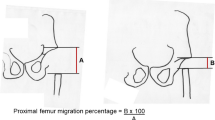Abstract
Background
At birth, no difference exists between the hips of children with spastic cerebral palsy and the hips of other children. The typical pathologic deformities of the hips in children with spastic cerebral palsy develop as the child gets older. One of our goals was to evaluate the change in quality of life of children with cerebral palsy after hip reconstruction. For classification of the children’s condition, we assessed sitting and standing abilities and used the Gross Motor Function Classification System. To evaluate the effect of hip dislocation on the spine, we assessed symmetry while the patient was lying down, sitting, and standing.
Methods
The results of surgical reconstruction of hip joints in 54 patients with severe cerebral palsy who had 66 severely subluxated or dislocated hip joints were retrospectively analyzed. The study was based on a research questionnaire with a mean follow-up of 4 years 10 months. The purpose of the questionnaire was to evaluate the pain, functional abilities, symmetry, and independence of the patients by using the modified Barthel index.
Results
Pain was fully relieved in 62 and was eased in 35% of preoperatively painful hips. The functional abilities of sitting and standing were not influenced statistically significantly by the operation. An improvement in sitting symmetry was observed in 40% and improvement in lying symmetry was observed in 32% of the patients. The mean center-edge angle improved from −24.9° ± 39° (mean ± standard deviation) to 25.9° ± 14°. The acetabular index improved from 30.2° ± 8° to 17.1° ± 7°.
Conclusions
The independence of the patients, based on the modified Barthel index, did not change significantly after surgery. Most improvements in quality of life were observed in those patients who had pain in the hip before the operation as a result of reduction of pain and improved mobility of the hip.






Similar content being viewed by others
References
Cornell MS (1995) The hip in cerebral palsy. Dev Med Child Neurol 37:3–18
Fabry G, MacEwen GD, Shands AR Jr (1973) Torsion of femur. A follow up study in normal and abnormal conditions. J Bone Joint Surg Am 55:1726–1138
Massie WK, Howorth MB (1950) Congenital dislocation of the hip. Part I. Method of grading results. J Bone Joint Surg Am 32:519–531
Laplaza FJ, Root L, Tassanawipas A, Glasser DB (1993) Femoral torsion and neck-shaft angles in cerebral palsy. J Pediatr Orthop 13:192–199
Heimkes B, Stotz S, Heid T (1992) Pathogenesis and prevention of spastic hip dislocation [in German]. Z Orthop Ihre Grenzgeb 130:413–418
Siffert RS (1981) Patterns of deformity of the developing hip. Clin Orthop Relat Res 160:14–29
Samilson RL, Tsou P, Aamoth G, Green WM (1972) Dislocation and subluxation of the hip in cerebral palsy. J Bone Joint Surg Am 54:863–873
Vidal J, Deguillaume P, Vidal M (1985) The anatomy of the dysplastic hip in cerebral palsy related to prognosis and treatment. Int Orthop 9:105–110
World Health Organization (1993) International classification of impairments, disabilities and handicaps. World Health Organization, Geneva
World Health Organization: international classification of functioning and disability. ICIDH-2. Available at http://www.who.int/ (last accessed, 18 July, 2005)
Ketelaar M, Vermeer A, Helders PJ (1998) Functional motor abilities of children with cerebral palsy. A systematic literature review of assessment measures. Clin Rehabil 12:369–380
Shah S, Vanclay F, Cooper B (1989) Improving the sensitivity of the Barthel index for stroke rehabilitation. J Clin Epidemiol 42:703–709
Mahoney FI, Barthel DW (1965) Functional evaluation. The Barthel index. Md State Med J 14:61–65
Wiberg G (1939) Studies on dysplastic acetabula and congenital subluxation of the hip joint. With special reference to the complication of osteoarthritis. Acta Chir Scand 83[Suppl 58]:1–135
Hilgenreiner H (1925) Early diagnosis and treatment of developmental dysplasia of the hip [in German]. Med Klin 21:1385–1425
Salter RB, Hansson G, Thompson GH (1984) Innominate osteotomy in the management of residual congenital subluxation of the hip in young adults. Clin Orthop Relat Res 182:53–68
Pemberton PA (1965) Pericapsular osteotomy of the ilium for treatment of congenital subluxation and dislocation of the hip. J Bone Joint Surg Am 47:65–86
Gordon JE, Capelli AM, Strecker WB, Delgado ED, Schoenecker PL (1996) Pemberton pelvic osteotomy and varus rotational osteotomy in the treatment of acetabular dysplasia in patients who have static encephalopathy. J Bone Joint Surg Am 78:1863–1871
Brunner R, Baumann JU (1994) Clinical benefit of reconstruction of dislocated or subluxated hip joints in patients with spastic cerebral palsy. J Pediatr Orthop 14:290–294
Root L, Laplaza FJ, Brourman SN, Angel DH (1995) The severely unstable hip in cerebral palsy. Treatment with open reduction, pelvic osteotomy, and femoral osteotomy with shortening. J Bone Joint Surg Am 77:703–712
Stasikelis PJ, Ridgeway SR, Pugh LI, Allen BL Jr (2001) Epiphyseal changes after proximal femoral osteotomy. J Pediatr Orthop B 10:25–29
Miller F, Cardoso Dias R, Dabney KW, Lipton GE, Triana M (1997) Soft-tissue release for spastic hip subluxation in cerebral palsy. J Pediatr Orthop 17:571–584
Gormley ME, Gaebler-Spira D, Delgado MR (2001) Use of botulinum toxin type A in pediatric patients with cerebral palsy. A three-center retrospective chart review. J Child Neurol 16:113–118
Koman LA, Mooney JF 3rd, Smith B, Goodman A, Mulvaney T (1993) Management of cerebral palsy with botulinum-A toxin. Preliminary investigation. J Pediatr Orthop 13:489–495
Stasikelis PJ, Davids JR, Johnson BH, Jacobs JM (2003) Rehabilitation after femoral osteotomy in cerebral palsy. J Pediatr Orthop B 12:311–314
Noonan KJ, Walker TL, Kayes KJ, Feinberg J (2001) Varus derotation osteotomy for the treatment of hip subluxation and dislocation in cerebral palsy. Statistical analysis in 73 hips. J Pediatr Orthop B 10:279–286
Morris C, Bartlett D (2004) Gross Motor Function Classification System: impact and utility. Dev Med Child Neurol 46(1):60–65
Author information
Authors and Affiliations
Corresponding author
Electronic supplementary material
Below is the link to the electronic supplementary material.
About this article
Cite this article
Krebs, A., Strobl, W.M. & Grill, F. Neurogenic hip dislocation in cerebral palsy: quality of life and results after hip reconstruction. J Child Orthop 2, 125–131 (2008). https://doi.org/10.1007/s11832-008-0080-6
Received:
Accepted:
Published:
Issue Date:
DOI: https://doi.org/10.1007/s11832-008-0080-6




